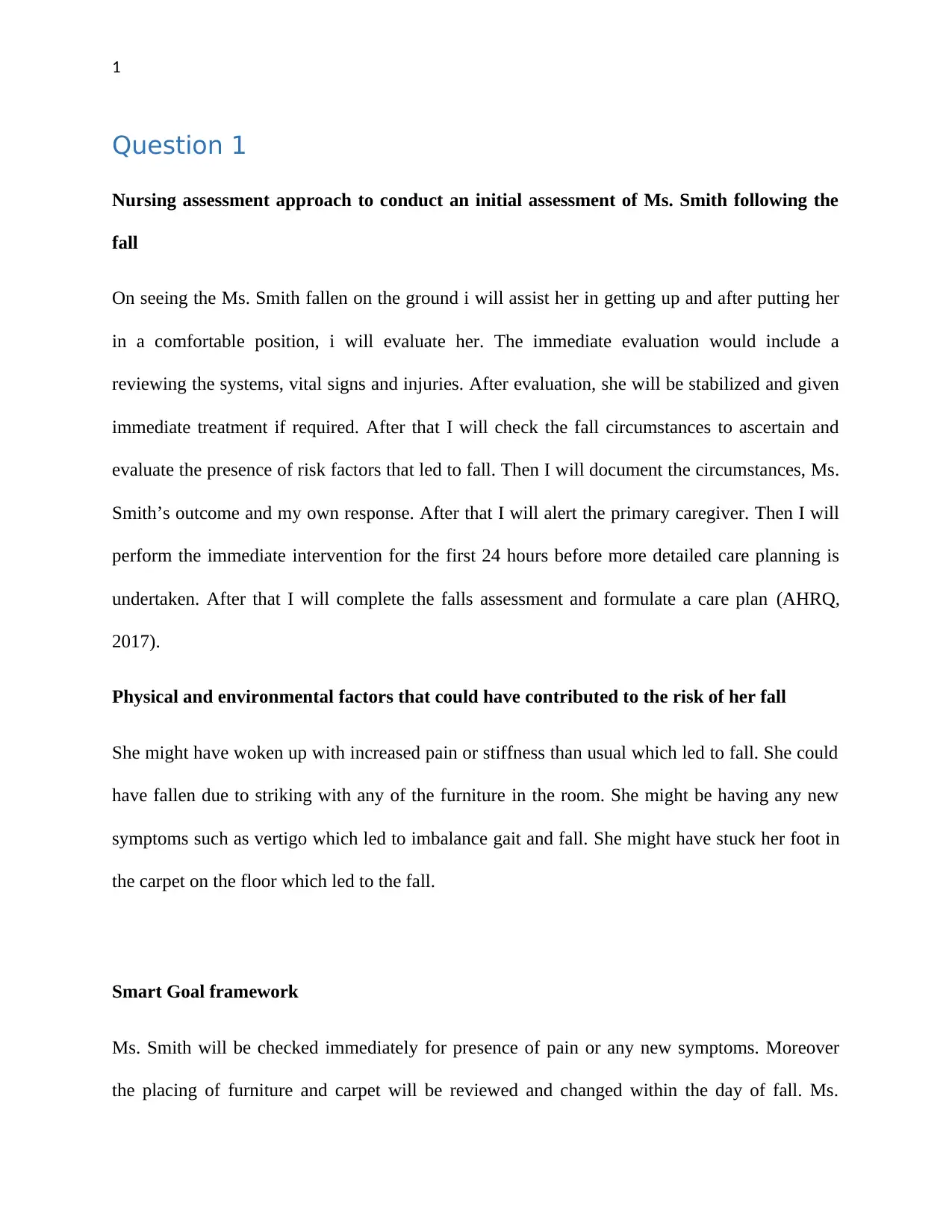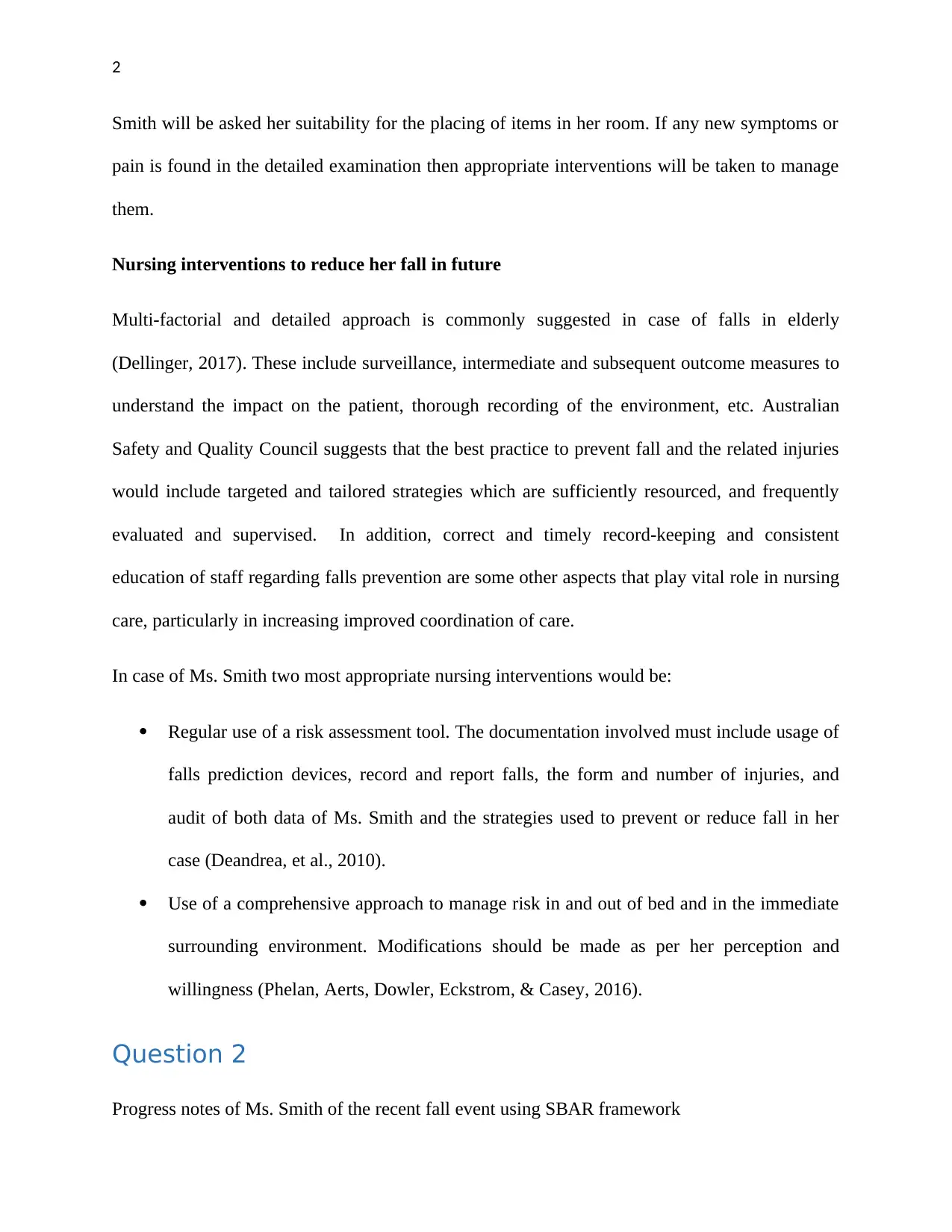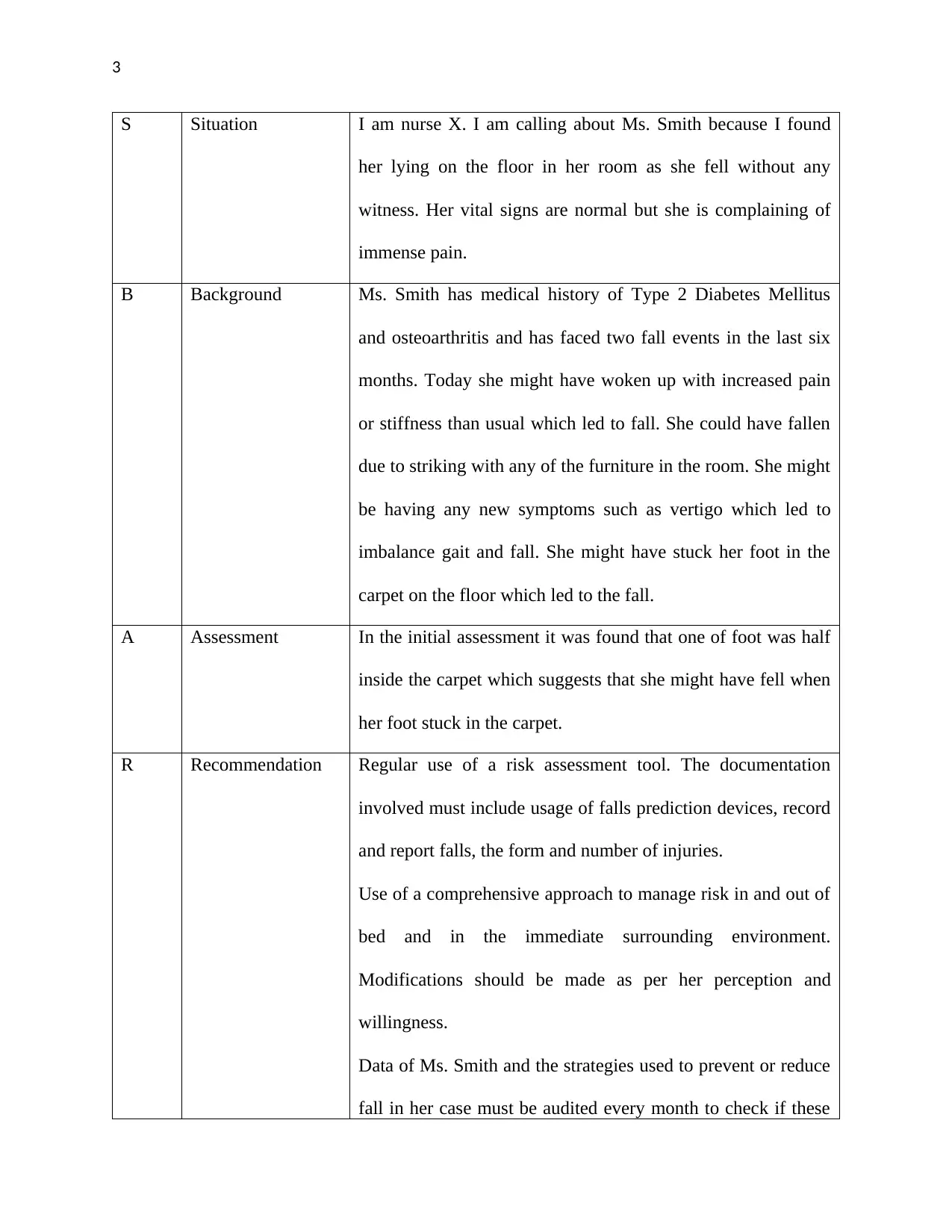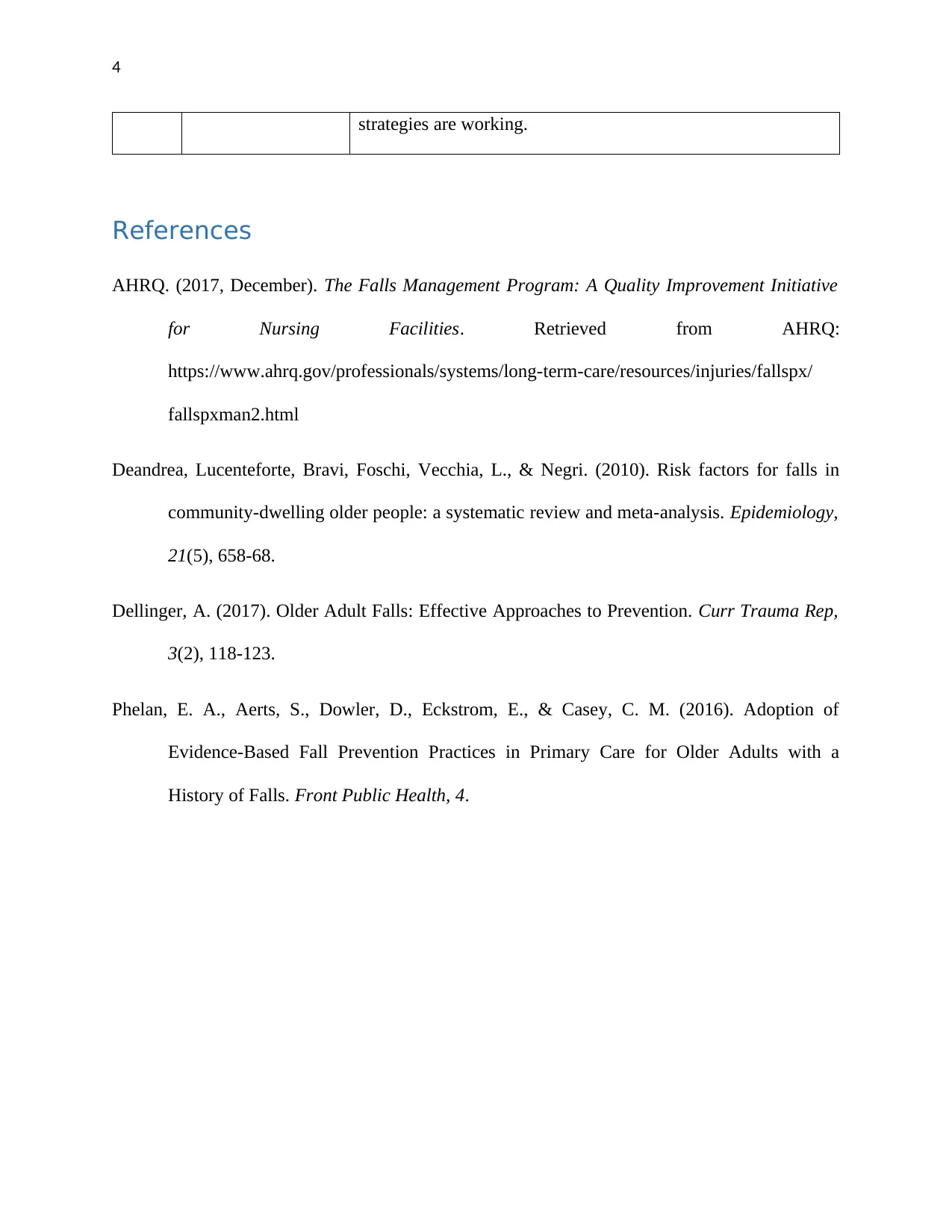Nursing Assessment, Interventions, and SBAR for Ms. Smith's Fall
VerifiedAdded on 2023/04/25
|4
|995
|243
Homework Assignment
AI Summary
This assignment focuses on a nursing assessment of Ms. Smith following a fall. It begins with an initial assessment, including vital signs and injury evaluation, followed by an analysis of potential risk factors contributing to the fall, such as environmental and physical elements like pain or carpet-related hazards. The assignment then outlines a SMART goal framework for immediate interventions, like furniture adjustments, and long-term fall prevention strategies, including the use of a risk assessment tool and a comprehensive approach to managing risks in the environment. The paper concludes with a progress note using the SBAR framework, detailing the situation, background, assessment findings, and recommendations for Ms. Smith's care. The provided references support the evidence-based approach to falls management in elderly patients.

1
Question 1
Nursing assessment approach to conduct an initial assessment of Ms. Smith following the
fall
On seeing the Ms. Smith fallen on the ground i will assist her in getting up and after putting her
in a comfortable position, i will evaluate her. The immediate evaluation would include a
reviewing the systems, vital signs and injuries. After evaluation, she will be stabilized and given
immediate treatment if required. After that I will check the fall circumstances to ascertain and
evaluate the presence of risk factors that led to fall. Then I will document the circumstances, Ms.
Smith’s outcome and my own response. After that I will alert the primary caregiver. Then I will
perform the immediate intervention for the first 24 hours before more detailed care planning is
undertaken. After that I will complete the falls assessment and formulate a care plan (AHRQ,
2017).
Physical and environmental factors that could have contributed to the risk of her fall
She might have woken up with increased pain or stiffness than usual which led to fall. She could
have fallen due to striking with any of the furniture in the room. She might be having any new
symptoms such as vertigo which led to imbalance gait and fall. She might have stuck her foot in
the carpet on the floor which led to the fall.
Smart Goal framework
Ms. Smith will be checked immediately for presence of pain or any new symptoms. Moreover
the placing of furniture and carpet will be reviewed and changed within the day of fall. Ms.
Question 1
Nursing assessment approach to conduct an initial assessment of Ms. Smith following the
fall
On seeing the Ms. Smith fallen on the ground i will assist her in getting up and after putting her
in a comfortable position, i will evaluate her. The immediate evaluation would include a
reviewing the systems, vital signs and injuries. After evaluation, she will be stabilized and given
immediate treatment if required. After that I will check the fall circumstances to ascertain and
evaluate the presence of risk factors that led to fall. Then I will document the circumstances, Ms.
Smith’s outcome and my own response. After that I will alert the primary caregiver. Then I will
perform the immediate intervention for the first 24 hours before more detailed care planning is
undertaken. After that I will complete the falls assessment and formulate a care plan (AHRQ,
2017).
Physical and environmental factors that could have contributed to the risk of her fall
She might have woken up with increased pain or stiffness than usual which led to fall. She could
have fallen due to striking with any of the furniture in the room. She might be having any new
symptoms such as vertigo which led to imbalance gait and fall. She might have stuck her foot in
the carpet on the floor which led to the fall.
Smart Goal framework
Ms. Smith will be checked immediately for presence of pain or any new symptoms. Moreover
the placing of furniture and carpet will be reviewed and changed within the day of fall. Ms.
Paraphrase This Document
Need a fresh take? Get an instant paraphrase of this document with our AI Paraphraser

2
Smith will be asked her suitability for the placing of items in her room. If any new symptoms or
pain is found in the detailed examination then appropriate interventions will be taken to manage
them.
Nursing interventions to reduce her fall in future
Multi-factorial and detailed approach is commonly suggested in case of falls in elderly
(Dellinger, 2017). These include surveillance, intermediate and subsequent outcome measures to
understand the impact on the patient, thorough recording of the environment, etc. Australian
Safety and Quality Council suggests that the best practice to prevent fall and the related injuries
would include targeted and tailored strategies which are sufficiently resourced, and frequently
evaluated and supervised. In addition, correct and timely record-keeping and consistent
education of staff regarding falls prevention are some other aspects that play vital role in nursing
care, particularly in increasing improved coordination of care.
In case of Ms. Smith two most appropriate nursing interventions would be:
Regular use of a risk assessment tool. The documentation involved must include usage of
falls prediction devices, record and report falls, the form and number of injuries, and
audit of both data of Ms. Smith and the strategies used to prevent or reduce fall in her
case (Deandrea, et al., 2010).
Use of a comprehensive approach to manage risk in and out of bed and in the immediate
surrounding environment. Modifications should be made as per her perception and
willingness (Phelan, Aerts, Dowler, Eckstrom, & Casey, 2016).
Question 2
Progress notes of Ms. Smith of the recent fall event using SBAR framework
Smith will be asked her suitability for the placing of items in her room. If any new symptoms or
pain is found in the detailed examination then appropriate interventions will be taken to manage
them.
Nursing interventions to reduce her fall in future
Multi-factorial and detailed approach is commonly suggested in case of falls in elderly
(Dellinger, 2017). These include surveillance, intermediate and subsequent outcome measures to
understand the impact on the patient, thorough recording of the environment, etc. Australian
Safety and Quality Council suggests that the best practice to prevent fall and the related injuries
would include targeted and tailored strategies which are sufficiently resourced, and frequently
evaluated and supervised. In addition, correct and timely record-keeping and consistent
education of staff regarding falls prevention are some other aspects that play vital role in nursing
care, particularly in increasing improved coordination of care.
In case of Ms. Smith two most appropriate nursing interventions would be:
Regular use of a risk assessment tool. The documentation involved must include usage of
falls prediction devices, record and report falls, the form and number of injuries, and
audit of both data of Ms. Smith and the strategies used to prevent or reduce fall in her
case (Deandrea, et al., 2010).
Use of a comprehensive approach to manage risk in and out of bed and in the immediate
surrounding environment. Modifications should be made as per her perception and
willingness (Phelan, Aerts, Dowler, Eckstrom, & Casey, 2016).
Question 2
Progress notes of Ms. Smith of the recent fall event using SBAR framework

3
S Situation I am nurse X. I am calling about Ms. Smith because I found
her lying on the floor in her room as she fell without any
witness. Her vital signs are normal but she is complaining of
immense pain.
B Background Ms. Smith has medical history of Type 2 Diabetes Mellitus
and osteoarthritis and has faced two fall events in the last six
months. Today she might have woken up with increased pain
or stiffness than usual which led to fall. She could have fallen
due to striking with any of the furniture in the room. She might
be having any new symptoms such as vertigo which led to
imbalance gait and fall. She might have stuck her foot in the
carpet on the floor which led to the fall.
A Assessment In the initial assessment it was found that one of foot was half
inside the carpet which suggests that she might have fell when
her foot stuck in the carpet.
R Recommendation Regular use of a risk assessment tool. The documentation
involved must include usage of falls prediction devices, record
and report falls, the form and number of injuries.
Use of a comprehensive approach to manage risk in and out of
bed and in the immediate surrounding environment.
Modifications should be made as per her perception and
willingness.
Data of Ms. Smith and the strategies used to prevent or reduce
fall in her case must be audited every month to check if these
S Situation I am nurse X. I am calling about Ms. Smith because I found
her lying on the floor in her room as she fell without any
witness. Her vital signs are normal but she is complaining of
immense pain.
B Background Ms. Smith has medical history of Type 2 Diabetes Mellitus
and osteoarthritis and has faced two fall events in the last six
months. Today she might have woken up with increased pain
or stiffness than usual which led to fall. She could have fallen
due to striking with any of the furniture in the room. She might
be having any new symptoms such as vertigo which led to
imbalance gait and fall. She might have stuck her foot in the
carpet on the floor which led to the fall.
A Assessment In the initial assessment it was found that one of foot was half
inside the carpet which suggests that she might have fell when
her foot stuck in the carpet.
R Recommendation Regular use of a risk assessment tool. The documentation
involved must include usage of falls prediction devices, record
and report falls, the form and number of injuries.
Use of a comprehensive approach to manage risk in and out of
bed and in the immediate surrounding environment.
Modifications should be made as per her perception and
willingness.
Data of Ms. Smith and the strategies used to prevent or reduce
fall in her case must be audited every month to check if these
⊘ This is a preview!⊘
Do you want full access?
Subscribe today to unlock all pages.

Trusted by 1+ million students worldwide

4
strategies are working.
References
AHRQ. (2017, December). The Falls Management Program: A Quality Improvement Initiative
for Nursing Facilities. Retrieved from AHRQ:
https://www.ahrq.gov/professionals/systems/long-term-care/resources/injuries/fallspx/
fallspxman2.html
Deandrea, Lucenteforte, Bravi, Foschi, Vecchia, L., & Negri. (2010). Risk factors for falls in
community-dwelling older people: a systematic review and meta-analysis. Epidemiology,
21(5), 658-68.
Dellinger, A. (2017). Older Adult Falls: Effective Approaches to Prevention. Curr Trauma Rep,
3(2), 118-123.
Phelan, E. A., Aerts, S., Dowler, D., Eckstrom, E., & Casey, C. M. (2016). Adoption of
Evidence-Based Fall Prevention Practices in Primary Care for Older Adults with a
History of Falls. Front Public Health, 4.
strategies are working.
References
AHRQ. (2017, December). The Falls Management Program: A Quality Improvement Initiative
for Nursing Facilities. Retrieved from AHRQ:
https://www.ahrq.gov/professionals/systems/long-term-care/resources/injuries/fallspx/
fallspxman2.html
Deandrea, Lucenteforte, Bravi, Foschi, Vecchia, L., & Negri. (2010). Risk factors for falls in
community-dwelling older people: a systematic review and meta-analysis. Epidemiology,
21(5), 658-68.
Dellinger, A. (2017). Older Adult Falls: Effective Approaches to Prevention. Curr Trauma Rep,
3(2), 118-123.
Phelan, E. A., Aerts, S., Dowler, D., Eckstrom, E., & Casey, C. M. (2016). Adoption of
Evidence-Based Fall Prevention Practices in Primary Care for Older Adults with a
History of Falls. Front Public Health, 4.
1 out of 4
Related Documents
Your All-in-One AI-Powered Toolkit for Academic Success.
+13062052269
info@desklib.com
Available 24*7 on WhatsApp / Email
![[object Object]](/_next/static/media/star-bottom.7253800d.svg)
Unlock your academic potential
Copyright © 2020–2025 A2Z Services. All Rights Reserved. Developed and managed by ZUCOL.




